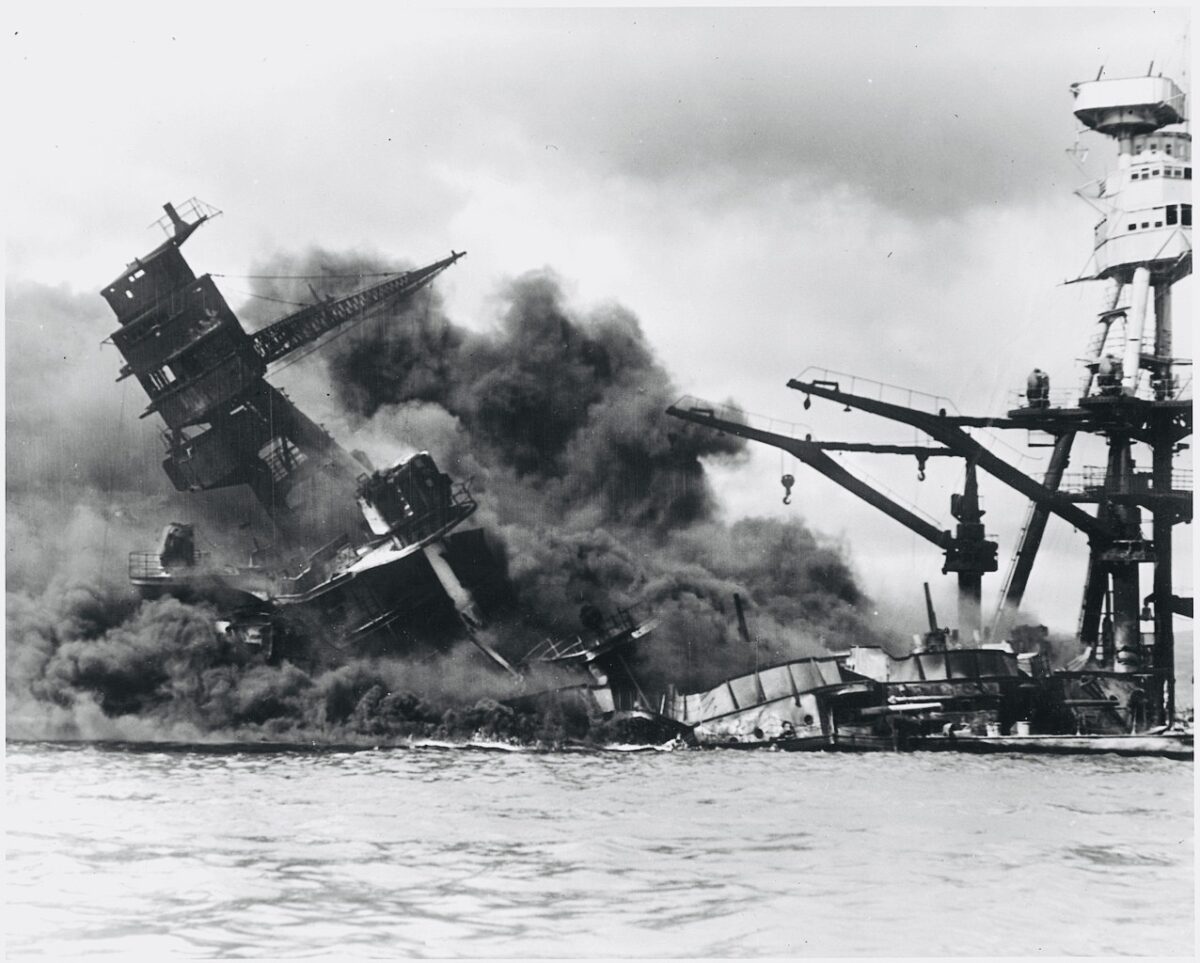The five momentous days from December 7 to December 11, 1941 were game changers, starting with Japan’s surprise attack on the U.S. Pacific fleet at Pearl Harbor and ending with Germany’s reckless and self-defeating declaration of war against the United States.
These events transformed World War II into a truly international conflict, write Brendan Simms and Charlie Laderman in Hitler’s American Gamble: Pearl Harbor and Germany’s March to Global War, published by Basic Books.
The tense interval between December 7 and December 11 was, as they argue in their cogent book, “the crucible for a new global alignment that would dramatically alter the course of the conflict.”
Judging by the outcome of the war, Japan and Germany made a stunning strategic miscalculation by declaring war on the United States. By doing so, they forced the U.S., a neutral power, to become a full-fledged combatant. America’s entry into the war not only sealed the fate of Adolf Hitler’s Nazi regime, but led to Japan’s defeat and the destruction of its colonial empire in Southeast Asia.
Simms and Laderman, both of whom are British historians, chart these historic developments with an amalgam of skill, knowledge and style.
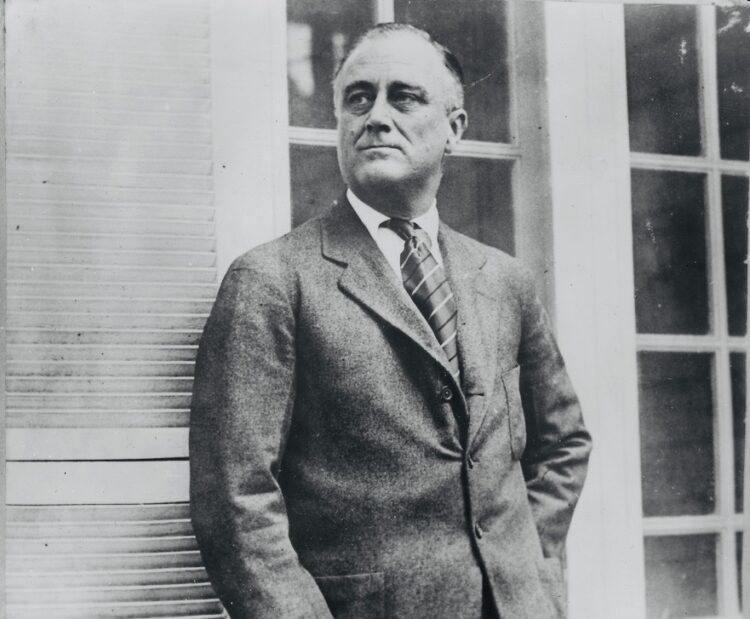
Until December 7, the United States was an isolationist power striving to avoid foreign entanglements. Yet from the late 1930s onwards, U.S. President Franklin D. Roosevelt gradually tilted away from Germany and Japan, both of which would morph into the greatest enemies of the United States.
Following the nation-wide Kristallnacht pogrom in Germany in 1938, the U.S. recalled its ambassador in Berlin, prompting the Germans to withdraw their envoy in Washington. Nevertheless, the U.S. continued to remain neutral after Germany’s invasion of Poland, but most Americans were sympathetic to the Allied cause.
On another front, Roosevelt imposed restrictions on the export of aviation fuel, lubricants and alloys to Japan after its aggression in Manchuria, Korea and China. With the Japanese occupation of the northern part of Indochina (Vietnam, Laos and Cambodia), Roosevelt banned the sale of steel and scrap iron to Japan.
The Roosevelt administration modified its policy again when it won congressional authority to transfer military equipment to any country deemed “vital” to American security. This gave rise to the Lend-Lease bill, which enabled the U.S. to prop up Britain and the Soviet Union in their armed confrontations with Germany. In the summer of 1941, U.S. troops relieved the British garrison in Iceland, thereby securing the area for the Allies.
William Shirer, an American foreign correspondent based in Berlin, took note of the clash between U.S. and German interests when he wrote of “two planets hurtling inexorably through the heavens towards each other.”
Hitler, blaming Jews for the deterioration in German-U.S. relations, met a senior Japanese diplomat in Berlin in April 1941 to discuss the simmering tensions. Hitler, while not seeking a war with the United States, told him that Germany would intervene on Japan’s side in the event of a Japanese-American war.
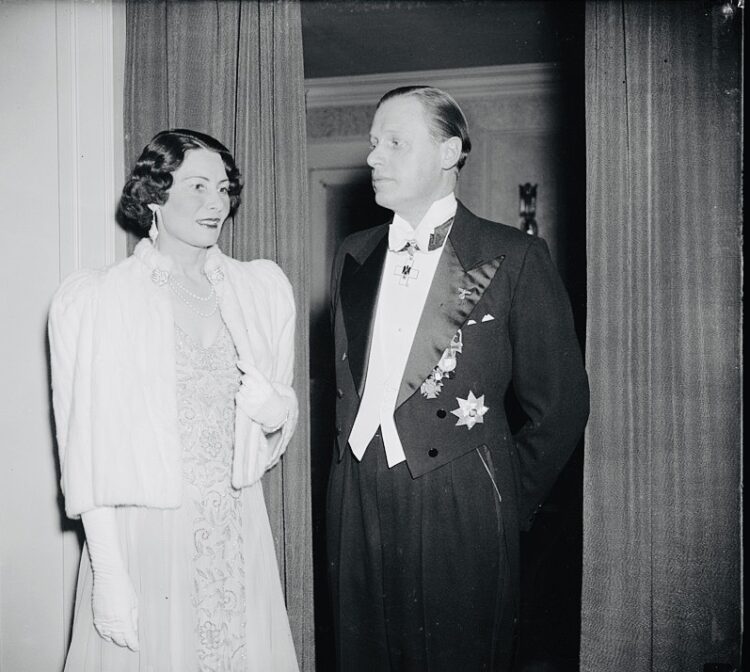
Germany’s charge d’affaires in Washington, Hans Thomsen, privately delivered an identical message to a prominent American Quaker. Later that year, German Foreign Minister Joachim von Ribbentrop informed Japan’s ambassador that Germany would “join the war immediately” should Japan find itself at war with the United States.
In the autumn of that fateful year, as the authors note, Germany greatly expanded the Auschwitz concentration camp in Poland, converting it into an extermination camp where more than one million Jews would be murdered. By then, the Erfurt-based company, J.A. Topf and Sons, had received an order from the Nazi regime to build crematoria in Auschwitz.
With Germany having halted Jewish emigration in October 1941, the deportation of German Jews got under way. Jews in Berlin, Cologne, Dusseldorf and Hamburg were deported eastward to ghettos in Poland and Latvia. Around the same time, Hitler repeated the “prophecy” he had made in January 1939, when he warned he would hold Jews responsible for a new world war.
Toward the end of November, top-level German officials from an assortment of ministries received invitations to attend the Wannsee conference in Berlin, which laid out a blueprint for the systematic annihilation of Jews in Nazi-occupied Europe.
The Japanese bombing of Pearl Harbor — which resulted in the destruction of 188 aircraft and eight battleships and the deaths of more than 1,000 sailors — prompted Roosevelt to point out that Japan had initiated a war with Russia in 1904 by striking its naval base at Port Arthur.
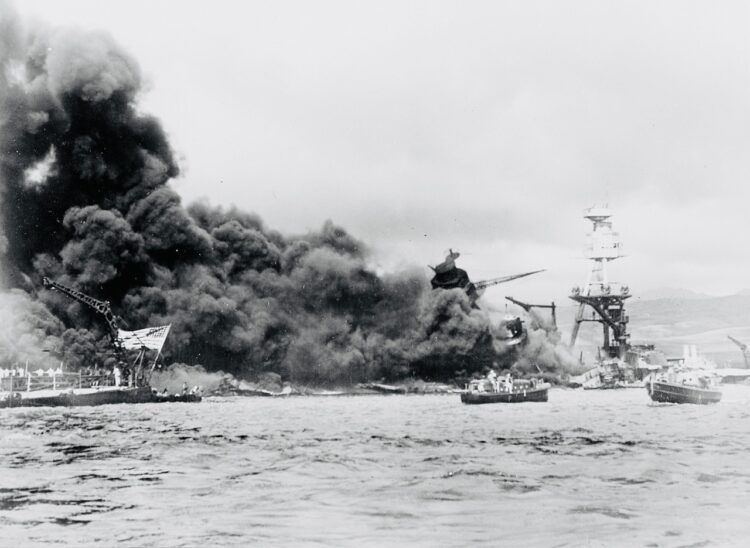
Initially, Roosevelt believed that Japan had acted “under pressure from Berlin.” Nonetheless, he refused to declare war on Germany. Canada, in the meantime, became the first English-speaking nation to declare war with Japan.
As the United States absorbed the shock of Pearl Harbor, the Germans liquidated the Riga ghetto in Latvia. The distinguished historian Simon Dubnow was one of the first Jews to be shot. Hundreds of others were killed in the Rumbula forest outside the city. In the Crimean town of Simferopol, a Nazi killing squad murdered some 1,500 Krymchaks, a community of Turkic Jews, in a single day.
At a joint session of Congress, Roosevelt condemned Japan’s “unprovoked and dastardly” attack on Pearl Harbor and announced that the two nations were officially at war.
The isolationist Charles Lindbergh supported the president’s declaration of war, as did The New York Daily News, a harsh critic of his foreign policy. Shortly after his speech, Roosevelt accused Germany of encouraging Japan to bomb Pearl Harbor.
Emboldened by its success at Pearl Harbor, Japan began working on an audacious plan to capture the Hawaiian islands and Wake Island from the United States. The Hawaiian operation was postponed, but the invasion of Wake Island was launched, resulting in Japan’s first defeat during World War II. Thailand, however, signed a treaty of alliance with Japan and proceeded to declare war on Britain and the United States.

As these events unfolded, Japan sank the pride of Britain’s navy, the Prince of Wales and the Repulse. British Prime Minister Winston Churchill was devastated by the castastrophe, having been assured that Japan was incapable of destroying such enormous and well-armed ships.
With the U.S. embroiled in a war with Japan, German Propaganda Minister Joseph Goebbels assumed that the Americans would no longer be able to send weapons to Britain and the Soviet Union under the Lend-Lease agreement.
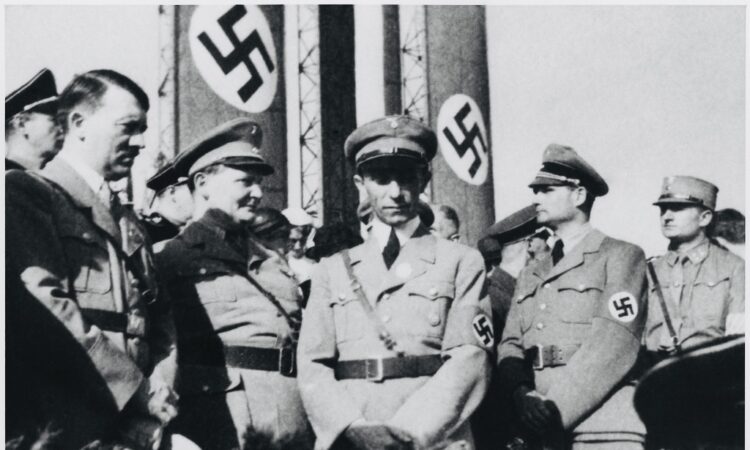
The British government was also concerned that the U.S.’ involvement in the Pacific war would have a negative impact on the flow of arms. This would not be the case.
The Soviet leader, Joseph Stalin, was under strong American pressure to declare war on Japan, but he declined, refusing to be drawn into a two-front war. Simms and Laderman speculate that the U.S. and Britain were actually ambivalent about a Soviet entry into the war with Japan because it might weaken its ability to fight Germany on the eastern front.
According to the authors, Pearl Harbor rejuvenated Hitler, who had grown disconsolate by horrendous battlefield losses in the Soviet Union. “The Fuhrer once again radiates a wave of optimism and confidence in victory,” Goebbels wrote in his diary.
The most senior professional diplomat in the German Ministry of Foreign Affairs, Ernst von Weizsacker, was not as sanguine, harboring doubts of the wisdom of going to war with the United States.
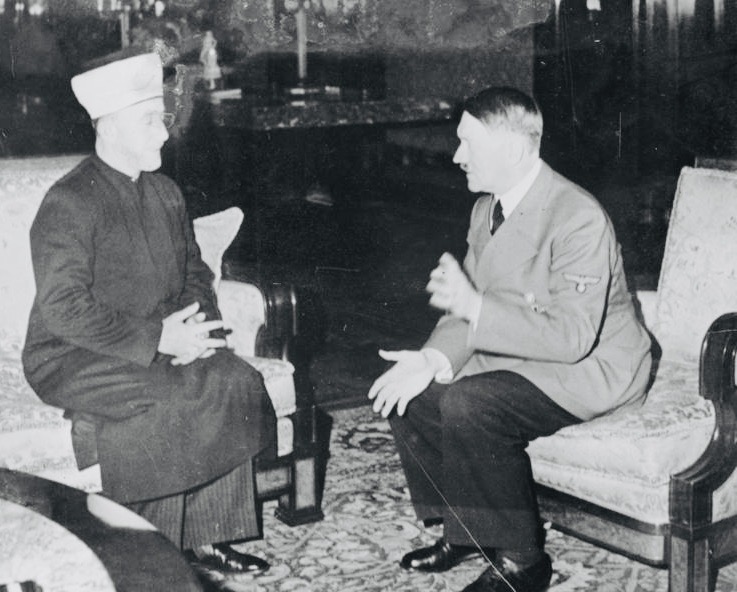
On the eve of Pearl Harbor, Hitler granted the grand mufti of Palestine, Haj Amin al-Husseini, an audience. During their meeting, he expressed his staunch opposition to a Jewish homeland in Palestine and his interest in “the destruction of the Jews living in the Arab lands under British protection.”
On December 11, on the day Germany, Italy and Japan signed the Axis agreement, Hitler officially declared war on the United States. He portrayed the war as a generational struggle that had been forced on him by Roosevelt and the “eternal Jew,” the power behind the president.
Foreign ambassadors and Nazi sympathizers, including the grand mufti of Palestine and the leaders of Nazi parties in occupied Holland and Norway, were invited to listen to Hitler’s speech.
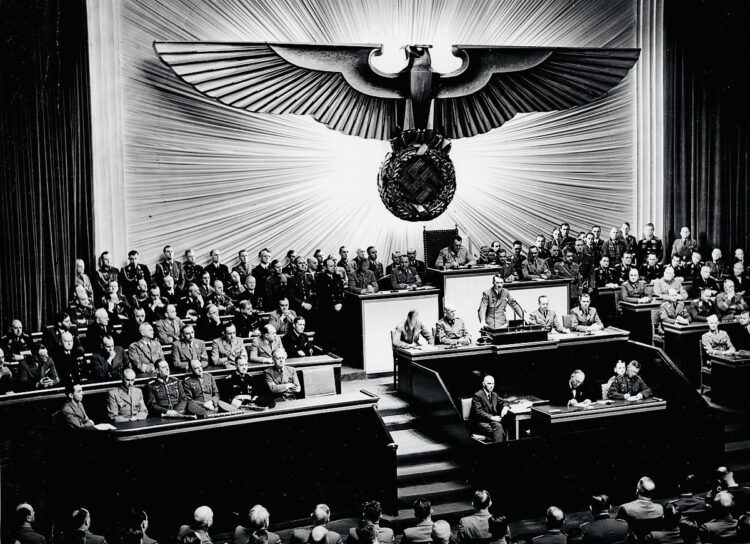
On the same day, Italy declared war on the United States, promising to establish a “just new order” in Europe.
In the days to follow, Hitler informed his gauleiters of his intention to resolve the so-called “Jewish question.” Being absolutely convinced that Jews had plunged the world into a war, he predicted that their “extermination must be the necessary consequence.”
For the Nazi regime and the Axis powers, the war was not only a geopolitical conflict, but also an ideological and racial one. For Japan, it was widely perceived as a war with “white people.” In an attempt to recruit allies, Japan appealed to the racial solidarity of Asians and to the anti-colonialism of Asian nationalists resisting Western imperialism. During this period, Japan invaded Hong Kong, the Philippines, Burma, Singapore, Guam and the Solomon Islands.
Fuelled by racial antagonism, the United States interned 110,000 Japanese Americans in special camps.
Germany’s declaration of war on the United States was a gamble that failed miserably. “This is a big development,” the Soviet journalist Pavel Luknitskiy wrote. “It will speed up the defeat of Hitler and the full destruction of the fascist empire.”
He was absolutely right.
